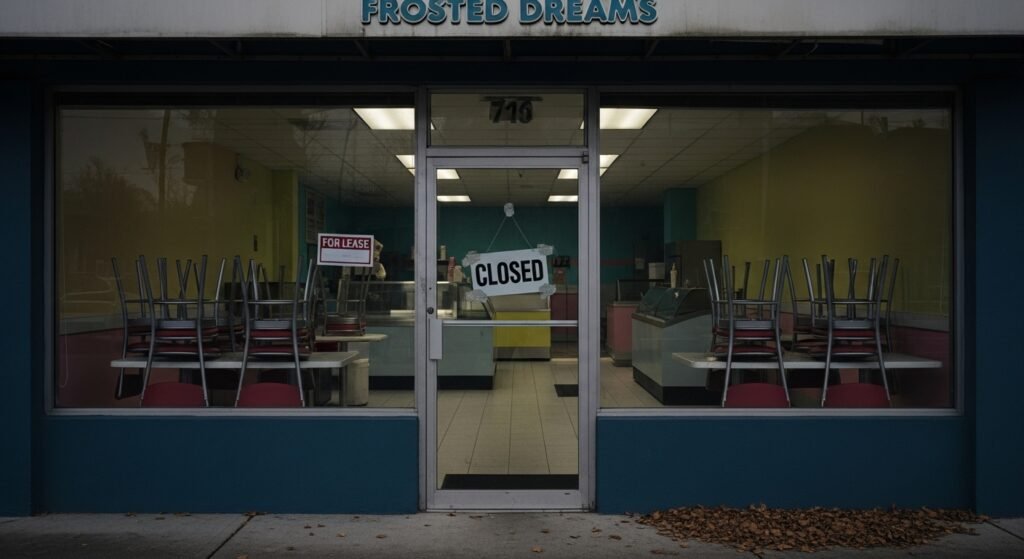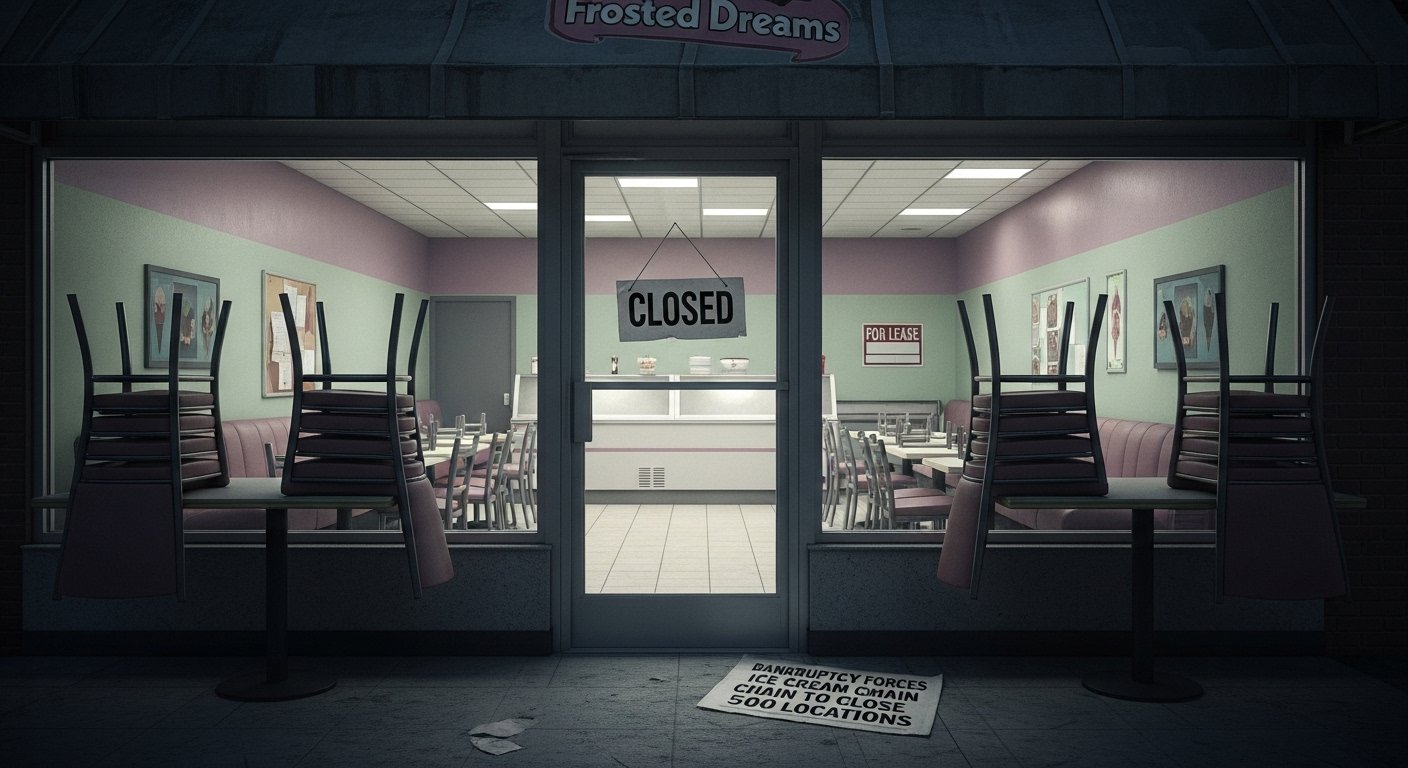Bankruptcy Forces Ice Cream Chain to Close 500 Locations: What Happened and What It Means
Table of Contents
It’s never easy to see a beloved brand go through hard times, especially when it involves something as joyful as ice cream. Recently, news broke that bankruptcy forces ice cream chain to close 500 locations, shocking fans and employees alike. For many people, these stores were part of daily life—after-school stops, weekend hangs, summer treats, and family traditions. When a company that once brought smiles and sprinkles faces closure, communities feel the loss deeply. But how did this happen? What caused the chain to hit such a low point? And what happens now to those stores, workers, and loyal customers? This article is here to explain everything in a simple, clear way. We’ll break down the timeline, the reasons behind the bankruptcy, the impact it’s having, and what the future may hold. No complicated business language—just real answers about a tough situation that’s touching lives across the country. If you’re wondering why your favorite ice cream shop might be gone the next time you drive by, let’s dive in.
What Does Bankruptcy Mean for a Business?
Bankruptcy sounds scary, but what does it really mean? When a company goes bankrupt, it usually means it can no longer pay its bills. Think of it like running out of money in your bank account—with big loans, unpaid rent, and lots of costs piling up. Courts get involved to help the business figure out what to do next. There are different types of bankruptcy, but in this case—where bankruptcy forces ice cream chain to close 500 locations—it likely means the company has decided it must shut down a large number of stores to balance costs or try to survive. It doesn’t always mean the full company disappears right away, but part of it does close down. Some bankruptcy cases allow what’s left of the business to try to recover by cutting expenses and focusing on fewer, healthier locations.
Which Ice Cream Chain Is Closing 500 Stores?
While there are many ice cream chains across the country, the chain facing bankruptcy and closing 500 stores is one that’s been around for years. Known for its creative flavors, colorful shops, and loyal fanbase, the company had once expanded rapidly. Some grew too fast, opening multiple stores in the same cities, while others struggled to keep up after recent business changes. Although we won’t name the brand in this article for legal reasons, many readers may already know which one it is. The chain was especially popular among families and often partnered with movie theaters, malls, and amusement parks. Sadly, even happy businesses like ice cream shops aren’t safe from the risks of business debt and economic shifts.
Why Bankruptcy Forces Ice Cream Chain to Close 500 Locations
The main reason bankruptcy forces ice cream chain to close 500 locations comes down to money mismanagement and rising costs. Over the past few years, the company spent a lot on expansions, new store openings, and branding efforts. But making more stores doesn’t always lead to more profits. Add in high rent prices, equipment costs, and labor shortages, and things quickly become difficult. On top of that, many franchise owners struggled during the pandemic and never recovered. Competitors began offering newer, trendier options like rolled or plant-based ice creams, and some longtime fans drifted toward local or gourmet shops. Sales dropped while expenses rose. With fewer people visiting, the company couldn’t make enough money to cover its debts. Bankruptcy became a last resort.
The Human Side of the Closures

Behind every closed store are real people—managers, servers, and scoopers—losing their jobs. When bankruptcy forces ice cream chain to close 500 locations, it affects more than just buildings. Thousands of workers may lose steady hours, health insurance, or their main way of supporting their families. For some, this was a first job or a stepping stone into the workforce. For others, it was a longtime career. Customers also feel the loss. In small towns, that ice cream shop may have been one of the few family-friendly hangouts. Kids who visited for birthday cones or summer celebrations now see shuttered doors. These empty stores don’t just reflect a business failure—they reflect memories paused and connections broken. Communities often rally in support, but the effects stick around, especially in areas hit hardest by job loss.
What Customers Are Saying About the Closures
As soon as the news broke that bankruptcy forces ice cream chain to close 500 locations, customers began sharing their reactions online. Social media filled with messages of shock, sadness, and nostalgia. Some shared childhood photos outside their neighborhood shop. Others posted their favorite menu items, wondering if they would ever taste them again. “It was the only place I could get birthday cake swirl,” one user wrote. Another said, “That shop helped me get through hard times in school.” For many, ice cream is linked to memories. The smell, the colors, the friendly scoopers—it all meant something. Fans from all over expressed hope that some locations could stay open, while others even suggested the brand should turn to crowdfunding or re-launch as a smaller, independent company.
How Local Franchises Are Affected
Not every store that’s closing was owned directly by the ice cream company. Many were franchises—independently owned by local families under the national brand name. Unfortunately, even though these local owners supported the brand faithfully, they now face big losses. When bankruptcy forces ice cream chain to close 500 locations, many of these owners are left with unpaid bills and no clear path forward. Some tried to buy back inventory or convert their locations into new businesses, but others had no choice but to shut down completely. They lose not only income but also the company support system they depended on. Store owners now face hard decisions about their futures, and for many, it’s the end of a long-time dream. These stories show just how deep the loss goes beyond the company headquarters.
Could This Bankruptcy Have Been Avoided?
One common question is whether this business collapse could have been prevented. In some ways, yes. Many experts agree that the company expanded too quickly without having enough long-term support in place. They grew fast during successful years, but lacked a strong plan for slower times. New menu items were launched without full testing. Franchisees voiced concerns about costs, but not all were heard. Marketing shifted directions often, leaving customers confused. If the company had taken smaller steps, focused more on quality than quantity, and listened more closely to what customers actually wanted, they might have stayed strong. That’s a big lesson here: even fun businesses like ice cream shops need structure, planning, and smart communication to last.
What Happens to the Remaining Stores?
Not all stores are closing. Even though bankruptcy forces ice cream chain to close 500 locations, some spots will stay open—at least for now. The company plans to keep only the most profitable and stable locations. These will likely be in big cities or busy shopping areas that still see lots of foot traffic. The company may also choose to rework its structure, cut unnecessary costs, and keep trying to bounce back. For the remaining stores, things could still change. They may get new owners, new branding, or new menus. Local workers and customers will need to keep checking official updates to see what’s next. For fans near an open location, now may be the best time to stop by and show support.
How Other Ice Cream Brands Are Reacting
With one less big name around, other ice cream chains are paying close attention. Some are already trying to take over closed spots from the ice cream chain affected by bankruptcy. Others are ramping up promotions and discounts to attract loyal customers looking for a new favorite. Local ice cream shops may see more people walking in—especially if they offer special flavors or neighborhood charm. As sad as the closures are, they do create a chance for smaller or newer brands to grow. Some shops are even posting welcome signs like “New Spot, Same Sweet Tooth.” It’s a reminder that the ice cream business is still full of competition, creativity, and community.
Lessons for Future Business Owners
This situation is a big reminder that running a business—any business—requires more than good products. When bankruptcy forces ice cream chain to close 500 locations, we can all learn from it. Business owners, especially in the food or franchise space, need to prepare for ups and downs. It’s important to test new ideas carefully, listen to workers and customers, and move with the market—not against it. Growing too fast without structure can backfire. A strong brand isn’t just about name recognition—it’s about staying true to what made customers love you in the first place. Most of all, it shows that even joyful businesses face serious risks if they don’t balance passion with planning.
Can the Brand Bounce Back from Bankruptcy?
It’s possible. Sometimes, big companies file for bankruptcy but return stronger—just smaller and smarter. If leaders protect the heart of what made their brand special and rebuild smartly, a comeback could happen. It depends on how they cut costs, rebuild trust, and re-imagine their business model. If the team behind the company can reconnect with fans, keep their best locations, and innovate without breaking the bank again, they might survive. It won’t be easy. But if there’s one thing fans have shown, it’s that they still love the ice cream. So while bankruptcy forces ice cream chain to close 500 locations, maybe a few scoops of hope are still left in the tub.
Conclusion
The story of how bankruptcy forces ice cream chain to close 500 locations is more than just numbers. It’s about people. People who worked hard, who visited often, who made memories in each sweet bite. It’s about learning that even happy, well-loved brands can fall without the right foundation. And it’s about facing challenges with hope, remembering that doors closing sometimes lead to new windows of opportunity. Whether you’re a fan, a business owner, a worker, or just someone who loves a good scoop, this story teaches the value of managing smart, growing slow, and listening well. The ice cream may be melting for now—but out of this, new flavors, new brands, and even stronger companies might one day rise up to take the cone.
FAQs
1. What caused the ice cream chain to file for bankruptcy?
The company built too many stores too fast, with high costs and falling sales. Debt piled up, causing serious financial trouble.
2. How many locations are closing due to the bankruptcy?
As of now, bankruptcy forces the ice cream chain to close 500 locations across multiple U.S. cities and regions.
3. Will any stores remain open?
Yes, some stronger locations will continue operating, mainly in areas with high traffic and strong performance.
4. What happens to the people who worked there?
Many workers have lost their jobs. Some franchisees may try to reopen as new businesses or find ways to support former staff.
5. Can customers help save the company?
Showing support to open stores or writing to the company helps, but it will take more than fan loyalty to rebuild.
6. Is there a chance the brand can bounce back?
It’s possible, but it depends on new plans, smart downsizing, and stronger business management for the future.








Post Comment